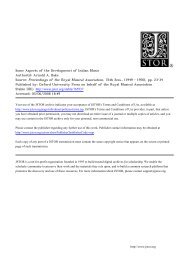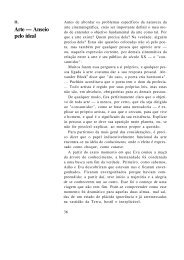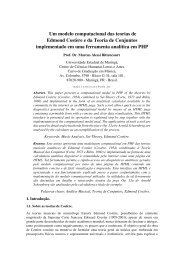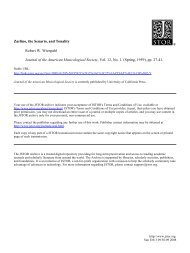- Page 2 and 3:
CORNELLUNIVERSITYLIBRARYBOUGHT WITH
- Page 4:
The original of this book isinthe C
- Page 9 and 10:
Augener's Edition No. 10118MODERN H
- Page 11:
PEEFATOEY NOTEThe present work is i
- Page 15 and 16:
CONTENTSCHAPTER IINTRODUCTORYFirst
- Page 17 and 18:
CONTENTSxiCHAPTER VIIALTERED NOTES
- Page 19:
CONTENTSxiiiCHAPTER XVMODERN FORMTh
- Page 22 and 23:
2 MODERN HARMONYschools, or whateve
- Page 24 and 25: 4 MODERN HARMONYfourths favoured by
- Page 26 and 27: 6 MODERN HARMONYmusic. The percepti
- Page 28 and 29: CHAPTER IIGREATER FREEDOM ON THE OL
- Page 30 and 31: 10 MODERN HARMONYEx.11.Meno mossei.
- Page 32 and 33: 12Ex.17.Tempo giustowMODERN HARMONY
- Page 34 and 35: 14Ex.24.VivacissimOjMODERN HARMONYP
- Page 36 and 37: 1 «16 MODERN HARMONYmultiply examp
- Page 38 and 39: 18MODERN HARMONYEx.37.LentoWAGNER,"
- Page 40 and 41: 20 MODERN HARMONYEx.42.A. HALM,"Har
- Page 42 and 43: MODERN HARMONYEx.47.Allegro espress
- Page 44 and 45: CHAPTER IIISCALES— (a)MODAX, INFL
- Page 46 and 47: 26 MODERN HARMONYEx.61.AUTHENTIC /c
- Page 48 and 49: 28Ex.58,Allegretto.MODERN HARMONYJ.
- Page 50 and 51: 30 MODERN HARMONYEx.60.Moderato.ELG
- Page 52 and 53: 32 MODERN HARMONYMany of the effect
- Page 54 and 55: 34 MODERN HARMONYthose are derived.
- Page 56 and 57: S6MODERN HARMONYI.—A Tonal Centre
- Page 58 and 59: i88 MODERN HARMONYEx.71.Andante.Voi
- Page 60 and 61: 40 MODERN HARMONYseem to be some po
- Page 62 and 63: 42 MODERN HARMONY^^^=^^^\h^K\%f^ft^
- Page 64 and 65: uMODERN HARMONYEx. 84.\^vace (quasi
- Page 66 and 67: 46 MODERN HARMONYEx. 90.Adagio, mis
- Page 68 and 69: MODERN HARMONYEx.95.Harmonic outlin
- Page 70 and 71: 50 MODERN HARMONY(a) a deliberate s
- Page 72 and 73: 62 MODERN HARMONYand such endings a
- Page 76 and 77: i56MODERN HARMONYDEBUSSY, "^Imagesl
- Page 78 and 79: 58 MODERN HARMONYEx. 118.Allegro bu
- Page 80 and 81: 60 MODERN HARMONYIt is the Impressi
- Page 82 and 83: 62 MODERN HARMONYEx.130.DEBUSSY,''C
- Page 84 and 85: (d)CHAPTER VIsome other scalesIn th
- Page 86 and 87: Jjjj|J].jijj^66 MODERN HARMONYEx.13
- Page 88 and 89: 'MODERN HARMONYGEORGES hue;"Surl'ea
- Page 90 and 91: 70MODERN HARMONYEx. 147.^Method of
- Page 92 and 93: 72 MODERN HARMONYEx. 152.C to C.Ex.
- Page 94 and 95: 74 MODERN HARMONYHow the composer d
- Page 96 and 97: 76Ex.162.Allegro.MODERN HARMONYSCRI
- Page 98 and 99: CHAPTER VIIALTERED NOTES AND ADDED
- Page 100 and 101: 80MODERN HARMONYAltered Notes in Ch
- Page 102 and 103: 82 MODERN HARMONYThe principle of a
- Page 104 and 105: 84 MODERN HARMONYMany passages in S
- Page 106 and 107: 86 MODERN HARMONYdiatonic structure
- Page 108 and 109: 88 MODERN HARMONYEx.183.Ex.t84.The
- Page 110 and 111: CHAPTER VIIINEW METHODS OP CHORD-ST
- Page 112 and 113: 92 MODERN HARMONYWhichever view of
- Page 114 and 115: 94 MODERN HARMONYEx.194.Largamente.
- Page 116 and 117: 96 MODERN HARMONYEx.198,(a) (b) (c)
- Page 118 and 119: 98 MODERN HARMONY(c)Mixed Structure
- Page 120 and 121: 100 MODERN HARMONYOther chords are
- Page 122 and 123: 102 MODERN HARMONYEx.220. MACKENZIE
- Page 124 and 125:
104MODERN HARMONYEx.j827.STRAUSS,"
- Page 126 and 127:
106 MODERN HARMONYto the tonic harm
- Page 128 and 129:
108 MODERN HARMONY^^•^'- Presto s
- Page 130 and 131:
110MODERN HARMONYEx.240.Allegro mod
- Page 132 and 133:
112Ex.245.MODERN HARMONYrail, molto
- Page 134 and 135:
CHAPTER XIMPKESSIONISTIC METHODSBef
- Page 136 and 137:
116 MODERN HARMONYBantock has shown
- Page 138 and 139:
118EX.2B7.MODERN HARMONY4llegroMntr
- Page 140 and 141:
120 MODERN HARMONYmuch better when
- Page 142 and 143:
122 MODERN HARMONYEx.268. . . , /J.
- Page 144 and 145:
124MODERN HARMONYEx.274.^Molto adag
- Page 146 and 147:
126 MODERN HARMONYis also real, the
- Page 148 and 149:
128 MODERN HARMONYThe example by St
- Page 150 and 151:
130 MODERN HARMONYThe foregoing rem
- Page 152 and 153:
132 MODERN HARMONYEx. 291.(Orch.)ii
- Page 154 and 155:
134 MODERN HARMONYmEx.295.(Chor.)(A
- Page 156 and 157:
136 MODERN HARMONYEx. 299.Andante m
- Page 158 and 159:
lasMODERN HARMONYVns.Vas,Fls. Obs,C
- Page 160 and 161:
I140 MODERN HARMONYLet us pass on t
- Page 162 and 163:
142 MODERN HARMONYExample 313 forms
- Page 164 and 165:
144 MODERN HARMONYonly of the devic
- Page 166 and 167:
146 MODERN HARMONYEx. 322.Allegro.B
- Page 168 and 169:
148 MODERN HARMONYEx. 327.Allegro v
- Page 170 and 171:
150 MODERN HARMONYEx. 338a.
- Page 172 and 173:
^(Scheme.)etc.152 MODERN HARMONYg^
- Page 174 and 175:
CHAPTER XIIliATBB HARMONIC TENDENCI
- Page 176 and 177:
156 MODERN HARMONYreach a point whe
- Page 178 and 179:
158 MODERN HARMONYWe now turn to a
- Page 180 and 181:
160 MODERN HARMONYIn Example 351 we
- Page 182 and 183:
162MODERN HARMONYEx. 355.• J: 68.
- Page 184 and 185:
164 MODERN HARMONYseem prone to int
- Page 186 and 187:
166 MODERN HARMONYAsiatics vocalize
- Page 188 and 189:
168 MODERN HARMONYThere is a sort o
- Page 190 and 191:
CHAPTER XIVMODERN RHYTHMThe term "r
- Page 192 and 193:
Ithe172 MODERN HARMONYNowadays, not
- Page 194 and 195:
174 MODERN HARMONYone of the beats.
- Page 196 and 197:
I176 MODERN HARMONYA recent innovat
- Page 198 and 199:
178 MODERN HARMONY"i ^ h 9 jk^ -'
- Page 200 and 201:
180 MODERN HARMONYand, indeed, all
- Page 202 and 203:
182 MODERN HARMONYcramping of the p
- Page 204 and 205:
184Ex.391.(a)Andante. ,MODERN HARMO
- Page 206 and 207:
186 MODERN HARMONYBridge.Subject. (
- Page 208 and 209:
188MODERN HARMONYEx.397,(a)^^Lento.
- Page 210 and 211:
190 MODERN HARMONYt^ jil\^- h^\iip
- Page 212 and 213:
192 MODERN HARMONYstyles of utteran
- Page 214 and 215:
194 MODERN HARMONYThe propeB apprec
- Page 216 and 217:
'196 MODERN HARMONYEx.402.Vivacecol
- Page 218 and 219:
198 MODERN HARMONYbut the most disa
- Page 220 and 221:
APPENDIX IEXERCISESAnything of the
- Page 222 and 223:
MODERN HARMONY11. Harmonise the fol
- Page 224 and 225:
204 MODERN HARMONY19. Harmonise for
- Page 226 and 227:
206 MODERN HARMONY26. Add 6 bars to
- Page 228 and 229:
208 MODERN HARMONY33. Write a short
- Page 230 and 231:
210 MODERN HARMONYIVMUSICAL FORM42.
- Page 232 and 233:
APPENDIX IIGLOSSARY OF TECHNICAL TE
- Page 234 and 235:
MODERN HARMONYConsecutive seconds,
- Page 236 and 237:
216 MODERN HARMONYLaissez vibrer, l
- Page 238 and 239:
218 MODERN HARMONYRegulated pulsati
- Page 240 and 241:
INDEX TO MUSICAL ILLUSTRATIONS{The
- Page 242 and 243:
22aBlgab (continued)Farjeon, H.Plot
- Page 244 and 245:
'224 MODERN HARMONYReger, MaxBlMSKY
- Page 246 and 247:
MODERN HARMONYMISCELLANEOUS.Chords,
- Page 248 and 249:
228 MODERN HARMONYBeethoven, Pastor
- Page 250 and 251:
230 MODERN HARMONYFive senses of mu
- Page 252 and 253:
232 MODERN HARMONYObscuring the Ton
- Page 254 and 255:
234 MODERN HARMONYStrauss, modernit
- Page 262:
"V '^5^^^^"V








